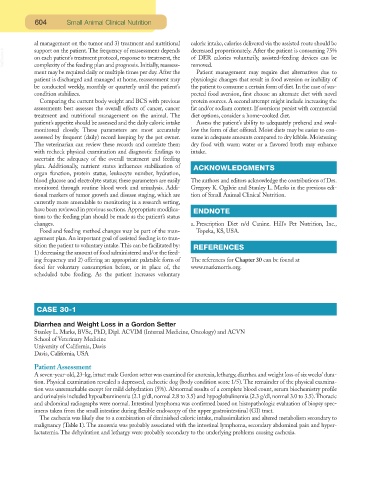Page 583 - Small Animal Clinical Nutrition 5th Edition
P. 583
604 Small Animal Clinical Nutrition
al management on the tumor and 3) treatment and nutritional caloric intake, calories delivered via the assisted route should be
VetBooks.ir support on the patient.The frequency of reassessment depends decreased proportionately. After the patient is consuming 75%
of DER calories voluntarily, assisted-feeding devices can be
on each patient’s treatment protocol, response to treatment, the
removed.
complexity of the feeding plan and prognosis. Initially, reassess-
ment may be required daily or multiple times per day. After the Patient management may require diet alternatives due to
patient is discharged and managed at home, reassessment may physiologic changes that result in food aversion or inability of
be conducted weekly, monthly or quarterly until the patient’s the patient to consume a certain form of diet. In the case of sus-
condition stabilizes. pected food aversion, first choose an alternate diet with novel
Comparing the current body weight and BCS with previous protein sources. A second attempt might include increasing the
assessments best assesses the overall effects of cancer, cancer fat and/or sodium content. If aversions persist with commercial
treatment and nutritional management on the animal. The diet options, consider a home-cooked diet.
patient’s appetite should be assessed and the daily caloric intake Assess the patient’s ability to adequately prehend and swal-
monitored closely. These parameters are most accurately low the form of diet offered. Moist diets may be easier to con-
assessed by frequent (daily) record keeping by the pet owner. sume in adequate amounts compared to dry kibble. Moistening
The veterinarian can review these records and correlate them dry food with warm water or a flavored broth may enhance
with recheck physical examination and diagnostic findings to intake.
ascertain the adequacy of the overall treatment and feeding
plan. Additionally, nutrient status influences stabilization of ACKNOWLEDGMENTS
organ function, protein status, leukocyte number, hydration,
blood glucose and electrolyte status; these parameters are easily The authors and editors acknowledge the contributions of Drs.
monitored through routine blood work and urinalysis. Addi- Gregory K. Ogilvie and Stanley L. Marks in the previous edi-
tional markers of tumor growth and disease staging, which are tion of Small Animal Clinical Nutrition.
currently more amendable to monitoring in a research setting,
have been reviewed in previous sections. Appropriate modifica- ENDNOTE
tions to the feeding plan should be made as the patient’s status
changes. a. Prescription Diet n/d Canine. Hill’s Pet Nutrition, Inc.,
Food and feeding method changes may be part of the man- Topeka, KS, USA.
agement plan. An important goal of assisted feeding is to tran-
sition the patient to voluntary intake.This can be facilitated by: REFERENCES
1) decreasing the amount of food administered and/or the feed-
ing frequency and 2) offering an appropriate palatable form of The references for Chapter 30 can be found at
food for voluntary consumption before, or in place of, the www.markmorris.org.
scheduled tube feeding. As the patient increases voluntary
CASE 30-1
Diarrhea and Weight Loss in a Gordon Setter
Stanley L. Marks, BVSc, PhD, Dipl. ACVIM (Internal Medicine, Oncology) and ACVN
School of Veterinary Medicine
University of California, Davis
Davis, California, USA
Patient Assessment
A seven-year-old, 23-kg, intact male Gordon setter was examined for anorexia, lethargy, diarrhea and weight loss of six weeks’ dura-
tion. Physical examination revealed a depressed, cachectic dog (body condition score 1/5). The remainder of the physical examina-
tion was unremarkable except for mild dehydration (5%). Abnormal results of a complete blood count, serum biochemistry profile
and urinalysis included hypoalbuminemia (2.1 g/dl, normal 2.8 to 3.5) and hypoglobulinemia (2.3 g/dl, normal 3.0 to 3.5).Thoracic
and abdominal radiographs were normal. Intestinal lymphoma was confirmed based on histopathologic evaluation of biopsy spec-
imens taken from the small intestine during flexible endoscopy of the upper gastrointestinal (GI) tract.
The cachexia was likely due to a combination of diminished caloric intake, malassimilation and altered metabolism secondary to
malignancy (Table 1). The anorexia was probably associated with the intestinal lymphoma, secondary abdominal pain and hyper-
lactatemia. The dehydration and lethargy were probably secondary to the underlying problems causing cachexia.

